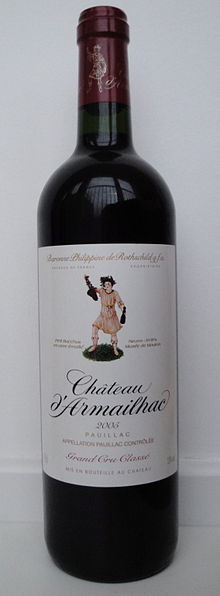Château d'Armailhac
The Château D'armailhac is a known vineyard of Bordeaux . Since the classification of 1855 the winery has been classified as Cinquième Grand Cru Classé (fifth level of classification).
The estate is in the Pauillac appellation and is medium-sized with around 50 hectares. 56% of the area with the grape variety Cabernet Sauvignon , 22% with Merlot and 20% with Cabernet Franc planted. In middle years the estate produces around 220,000 bottles of wine .
The vintages from 1995 onwards deserve special mention, all of which are in the very good range with wine ratings of more than 86 PP .
The winery is owned by Domaines Philippe de Rothschild, which also owns the neighboring Premier Cru estate, Château Mouton-Rothschild . The then neighboring estate Mouton-d'Armailhac was bought by Baron Philippe de Rothschild in 1933 , renamed Mouton-Baron-Philippe in 1956, renamed Mouton-Baronne-Philippe after his wife in 1975 and reopened by their daughter Philippine in 1989 after the death of their father renamed the old name d'Armailhac . There is often confusion with the name of the winery at auctions, for example , when the parts of the name “Mouton” and “Rothschild” appear: As a prospective buyer, you have to be very careful not to pay the prices of the Premier Cru wine for the Armailhac; Although it is usually a good red wine , its quality is far removed from its “big brother” Mouton.
history
The ownership structure of the agricultural land can be traced back to the early 14th century. In 1311 the land belonged to the feudal lord Pons de Castillon . As a result, the property was passed on to the family. In the 15th century the lands came to Humphrey, Duke of Gloucester , the younger brother of Henry V.
After the British defeat in the Hundred Years' War , the former English property passed into French hands. A small part of the property passed through the Foix family to the notary Jacques de Ségur. At that time, not only smaller plots of today's château belonged to the lands. Jacques de Ségur also laid the first vineyards on the site of today's Château Lafite-Rothschild from 1670. His son Alexandre married the heiress of Château Latour in 1695 . From this marriage the son Nicolas-Alexandre de Ségur (1697–1755) emerged. After Nicolas-Alexandre expanded the property of Mouton in 1717 and bought Château Calon-Ségur , he sold Mouton to Joseph de Brane in 1720 (other sources name the year 1725), thus initiating the separation of Mouton and Lafite. An existing manor building and the middle part of the land went to Dominique Armailhacq. François de Pontet bought the southernmost part of the land and thus laid the basis of Château Pontet-Canet .
In 1740 at the latest , wine was produced on the land of the property now known as Mouton-d'Armailhacq . Dominique had obtained the right to the name Mouton by purchasing the manor house. In 1750 the estate had a vineyard area of almost 16 hectares. Early attempts at classification in Bordeaux show, however, that Mouton-d'Armailhacq was always overshadowed by its direct neighbors Mouton and Pontet-Canet. A few decades after Dominique, the estate was administered by two brothers, one of whom was Joseph Odet d'Armailhacq the elder. Your entrepreneurial activities have been affected by the political environment. High tariffs and the so-called continental lock that lasted eight years made trading with the most important customer, the British, practically impossible. The d'Armailhacq brothers had to part with their winery in November 1843 for financial reasons. It was taken over in March 1844 by Joseph Odet's former wife for 398,000 francs . In order to finance the purchase, they parted immediately after taking over 32 journeaux (approx. 10 hectares ) of vacant land on the gravel knoll called Carruades. After a bidding duel between Goudal from Château Lafite and Lestapis from Château Mouton, she sold the area to Lestapis for 100,000 francs.
Mrs. d'Armailhacq bequeathed the estate to her son Armand d'Armailhacq, born in 1798. With scientific meticulousness, he reorganized the winery and was very committed to the growing spread of the Cabernet Sauvignon grape variety. He was also the author of De la Culture des Vignes, de la Vinification dans le Médoc et des Vins dans le Médoc , published in 1850 , which was reprinted several times until his death in 1870.
His qualitative efforts were crowned with the inclusion in the Bordeaux classification of the year 1855. According to its own information, the winery had an area of 63 hectares.
In 1857 Comte Adrien de Ferrand married Armand's sister, Alexandrine d'Armailhacq. From 1878 he took over the management of the estate and later handed it over to his son Roger de Ferrand, who was born in 1867. Due to the phylloxera crisis , various fungal diseases ( powdery mildew , downy mildew of the grapevine ) and the First World War , the winery was no longer profitable. In 1921, Roger tried to improve the financial situation with a newly founded wine trading company called Société vinicole de Pauillac .
In 1933 Philippe de Rothschild bought the winery and also took over the wine trading house. Via the Société vinicole de Pauillac, he was able to sell the poor vintage 1930, 1931 and 1932 Mouton-Rothschild as a branded wine with the name Mouton-Cadet .
literature
- Charles Cocks, Edouard Féret, Bruno Boidron: Bordeaux et ses vins . 18th edition. Èdition Féret et Fils, Bordeaux 2007, ISBN 978-2-35156-013-6 .
- Horst Dippel : The wine lexicon . 3. Edition. Fischer Taschenbuch Verlag, Frankfurt am Main 1999, ISBN 3-596-13826-4 .
- Robert Parker : Parker's Wine Guide (= Collection Rolf Heyne ). Heyne, Munich 2000, ISBN 3-453-16305-2 .
